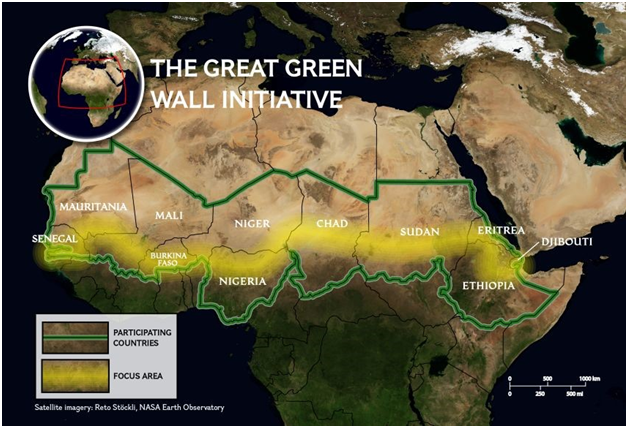Green Wall/ Bengal Barrier
Context: Experts question plan
What is the plan?
- West Bengal Pollution Control Board (WBPCB) has decided to set up 800 km Bio-Shield along its western fringe to stop pollutants from entering the State.
- Bio-Shield – A wall of Mega Plantations
- WBPCB says pollution from other states is responsible for close to half of West Bengal’s pollution load.
Why are experts against it?
- It’s possible that the execution will cost many crores, take years to complete, and be ineffective.
- Research has shown that during the winter, transboundary air pollutants, particularly the most harmful PM 2.5, typically migrate at least 500 metres above the surface, beyond the shield’s protection.
- Research reveals that, relative to other states, West Bengal receives less transboundary pollution.
- There is no proof that such a plan will succeed.
The Great Green wall of Sahel Region
- It is an effort to enhance the area that may be used for agriculture in the Sahel, a region that borders the Sahara Desert in Africa.
- Eleven countries, including Djibouti, Eritrea, Ethiopia, Sudan, Chad, Niger, Nigeria, Mali, Burkina Faso, Mauritania, and Senegal, are funding initiatives ranging from agroforestry to sustainable development.
- GEF, WB, UNFCCD, and other organisations are involved. According to UNEP, this programme is one of the ground-breaking ones that is reviving nature.
Other Initiatives:
Great Green Wall of Africa
- It aspires to change millions of lives in the Sahel, one of the world’s poorest regions, and repair Africa’s damaged environments.
- Only 15% of the African project has been completed so far.
- The Wall, an 8,000 km natural wonder spanning the whole breadth of the continent, will be the largest living structure on the earth once it is entirely constructed.
- African nations requested financial assistance from the international community at the UNCCCD COP14 in order to build the Wall in the Sahel part of their continent by 2030.
- Sahel is a semiarid region of western and north-central Africa extending from Senegal eastward to Sudan.
- It forms a transitional zone between the arid Sahara (desert) to the north and the belt of humid savannas to the south.
Aravali Mountain Range
- The Aravallis are the planet’s oldest fold mountains. According to geological studies, it is three billion years old.
- Over 800 kilometres separate Gujarat from Delhi (through Rajasthan and Haryana).
- The Guru Peak atop Mount Abu is the highest peak in the Aravalli Range.
- Influences Climate:
- The climate of northwest India and beyond is impacted by the Aravallis.
- The mountain range nurtures the sub-Himalayan rivers and feeds the north Indian plains by gently guiding the monsoon clouds eastward towards Shimla and Nainital during monsoon season.
- It shields the productive alluvial river valleys (such as the para-Indus and Gangetic) from the harsh winter winds that blow in from Central Asia.





